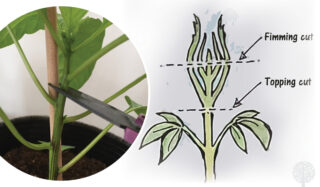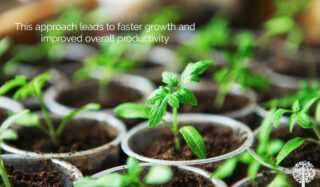What’s The Early Topping Technique, And How Can It Help Your Grow?
In December 2020, my business partner handed me a research paper sent to her from a grower/researcher in Quebec named Sylvain Gaudreau. I had no idea how much of an impact Sylvain and his work would have on me and my approach to propagation in commercial growing facilities. The paper was about a propagation technique that augments a crop’s yield.
Topping Plants
In commercial cultivation, plants are typically propagated through cuttings – a process known as cloning. Many producers use techniques like topping or ‘fimming’ to stimulate the growth of axillary shoots, which increases the number of flowers per plant and, consequently, the overall yield. Topping or fimming is usually done after the cuttings have been in rooting media for about two weeks.
Sylvain and his team tested a new approach to boost shoot development per plant. This method involves topping the mother plant(s) before taking cuttings for cloning, with the cuttings collected one week after the topping. This modification results in faster development of the axillary shoots and reduces the time from cutting to harvest by 7-10 days. This new method requires only minor adjustments to the existing workflow and yields similar results to the standard topping procedure – but it shortens production time by nearly two weeks because the plantlets do not need to recover after topping. This approach leads to faster growth and improved overall productivity.


How Does It Work?
Since the technique is being performed on the mother plant(s), there is a much larger and more robust root system to work with. Within that system lies all of the growth hormones. Topping/fimming stimulates the plant’s survival mechanism.
With the mother in a panicked state, the plant takes all of those growth hormones and distributes them throughout the plant – this creates new apexes to replace what has been removed. Here’s where the genius of Mother Nature comes in – the plant won’t create just one apex, but multiple apex shoots to ensure its survival. With the mother plant growing under stable and favorable conditions – and not in the wild – all new growth will survive, resulting in cuts with multiple apex clones that are charged with more growth hormones than conventionally taken clones.
How Does This Help?
This technique gives the grower pre-topped clones that will have multiple apexes. This eliminates the need for topping once the plantlet leaves propagate, saving the operation 7-10 days of production per crop and a faster time to flipping/kicking the plants into flower. This technique increases yield, gives better uniformity to the canopy, and, most importantly, faster cloning time – which has been the most exciting aspect of early topping (for me!). The cuttings seem to root much quicker than traditionally taken clones. We saw ‘fish bones’ (the start of rooting) within 3-5 days, and our clones were ready for transplant in 10 days, which helped increase our production and the number of crops we could grow in a calendar year.


A Widespread Approach
In the years following Sylvain’s research, it has been discovered that the technique works on most plants that produce flowers. The tobacco industry uses it, as do marigolds (a paper is currently being written on this). The Early Topping Technique is being performed on hemp plants used to scrub the soil around the Joseph V. Stalin nuclear power plant.
In China, cultivating small peas in a vertical growing environment using prolonged periods of light in conjunction with ETT has increased yield tenfold. The Chinese researchers growing the peas published a paper based on their findings and Sylvain’s work.
The Vatican has even downloaded Sylvain’s paper to their horticulture archives for further research. As of the writing of this article, the paper has been downloaded 100,000 times in 102 countries. It has also been tested on over 3000 cultivars with a 100% success rate and has been proven to work commercially in numerous agricultural operations.
As a grower, I want the highest product quality and yield. The Early Topping Technique gives my operations the best chance at achieving those goals. I can’t thank Sylvain enough for his research and time teaching my team about it. If you’d like to read the study, please see the link:




